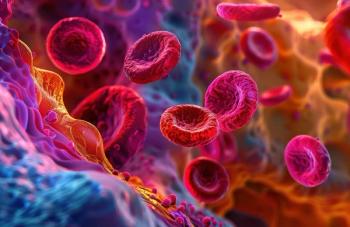
Valoctocogene Roxaparvovec Dramatically Reduces Bleeding in Hemophilia A
New study findings demonstrate that valoctocogene roxaparvovec, a gene therapy for severe hemophilia A, significantly reduces bleeding episodes and dependency on factor VIII infusions over a 3-year period, while maintaining a favorable safety profile.
A 3-year study,
Hemophilia A, a genetic disorder characterized by a deficiency in human FVIII, leads to severe and spontaneous bleeding episodes, significantly affecting patient quality of life. Conventional treatment for hemophilia A involves regular infusions of exogenous FVIII or nonfactor replacement therapies, both of which require frequent hospital visits and can disrupt daily life.2 Valoctocogene roxaparvovec is an adeno-associated virus 5 (AAV5)-based gene therapy vector that works by providing a functional copy of the FVIII gene to the patient's liver cells, which then begin to produce endogenous FVIII and provide protection against bleeding.
The GENEr8-1 study was a multicenter, open-label, single-arm, phase 3 trial that aimed to present safety and efficacy data for valoctocogene roxaparvovec. The study enrolled 134 adult males, aged 18 to 70 years, with severe hemophilia A (defined as having FVIII activity of 1 IU/dL or less) who were receiving long-term FVIII prophylaxis. Patients with a history of FVIII inhibitors or anti-AAV5 antibodies were excluded from the study.
Participants received a single infusion of valoctocogene roxaparvovec at a dose of 6 x 1013 vg/kg. Of the 134 participants, 22 enrolled directly in GENEr8-1 and 112 enrolled from the 270-902 trial (rollover population), which was a prospective, noninterventional, observational study involving individuals with severe hemophilia A.3 Two of the participants who directly enrolled were found to be living with HIV and were excluded from the modified intent-to-treat population due to markedly elevated liver enzymes after receiving a valoctocogene roxaparvovec dose of 4 x 1013 vg/kg.
By the end of the 3-year study period, 131 of the 134 participants remained in the study. The mean treated ABR decreased from 4.8 bleeds per year at baseline to 0.97 in the third year, representing an 80% reduction. Furthermore, annualized FVIII utilization was reduced by 94.2% in year 3 compared with baseline. Additionally, 92% of patients were off prophylaxis at the end of year 3, and those who returned to FVIII or emicizumab prophylaxis did so safely, according to the study results.
"I am encouraged to see the consistent clinical response and the significant number of study participants who remain off prophylaxis after 3 years. This shows the potential transformative impact of this single treatment event for people with severe hemophilia A," said investigator Steven Pipe, MD,
The safety profile after 3 years of therapy remained consistent with that already reported in the medical literature. The most common adverse event was mildly elevated alanine aminotransferase.
"Valoctocogene roxaparvovec provides hemostatic efficacy with unchanged safety after 3 years. Outcomes will be assessed for up to 15 years post treatment," the authors noted.
Postmarketing phase 4 trials are planned to confirm the real-world applicability of these results.
References
1. Madan B, Ozelo MC, Raheja P, et al. Three-year outcomes of valoctocogene roxaparvovec gene therapy for hemophilia A. J Thromb Haemost. Published online April 11, 2024. doi:10.1016/j.jtha.2024.04.001
2. Srivastava A, Santagostino E, Dougall A, et al. WFH guidelines for the management of hemophilia, 3rd edition. Haemophilia. 2020;26(supp 6):1-158. doi:10.1111/hae.14046
3. Kenet G, Chen YC, Lowe G, et al. Real-world rates of bleeding, factor VIII use, and quality of life in individuals with severe haemophilia A receiving prophylaxis in a prospective, noninterventional study. J Clin Med. 2021;10(24):5959. doi:10.3390/jcm10245959
4. BioMarin announces stable and durable annualized bleed control for Roctavian in largest phase 3 gene therapy study in adults with severe hemophilia A; 134-participant study met all primary and secondary efficacy endpoints at 3-year analysis. News release. BioMarin. January 8, 2023. Accessed May 7, 2024.
Newsletter
Stay ahead of policy, cost, and value—subscribe to AJMC for expert insights at the intersection of clinical care and health economics.





























































